Evaluating the Real-World NOx Emission from a China VI Heavy-Duty Diesel Vehicle
Abstract
1. Introduction
2. Experiments and Materials
2.1. Tested Vehicle
2.2. Portable Emissions Measurement System (PEMS)
2.3. Test Route
2.4. Moving Averaging Window (MAW) Method
- -
- is the cumulative engine work measured between the start and time , kWh;
- -
- is the amount of work produced over the WHTC, kWh;
- -
- shall be selected by Equation (2):where is the data sampling period, equal to 1 s or less.
- -
- is the cumulative mass of the pollutant of the window, g/window;
- -
- is the cumulative engine work during the averaging window, kWh.
2.5. Boundary Conditions for Data Evaluation
- Ambient temperature: between −7 and 38 °C.
- Altitude: not more than 2400 m.
- Test route: as abovementioned in “2.3 Test Route” (including trip share and vehicle speed, etc.).
- Cold start: at the beginning of the PEMS test, the engine coolant temperature shall not exceed 30 °C unless the ambient temperature is higher than 30 °C, in this case, the engine coolant temperature shall not be 2 °C higher than the ambient temperature. The data used for emissions evaluation is recorded after the engine coolant temperature has reached 70 °C for the first time or after the coolant temperature is stabilized within ±2 °C over a period of 5 min (whichever comes first but not later than 20 min after engine starts).
- Payload: 10 to 100% of the maximum vehicle payload.
- Cumulative work: 4~7 times the amount of work performed over the WHTC applicable to the engine used by the tested vehicle.
- Selection of valid windows: the valid windows are the windows whose average power exceeds the power threshold of 20% of the maximum engine power. The percentage of valid windows shall be equal or greater than 50%. If the percentage of valid windows is less than 50%, the data evaluation shall be repeated using lower power thresholds. The power threshold shall be reduced in steps of 1% until the percentage of valid windows is equal to or greater than 50%.
- Power Threshold: In any case, the power threshold shall not be lower than 10%, otherwise, the test shall be void.
- The pass-fail conditions for a valid test are as follows:
- The 90th cumulative percentile of the valid windows emissions shall be less than the limit required in the regulation (for China VI, NOx limit: 0.690 g/kWh; CO limit: 6 g/kWh; PN limit: 1.2 × 1012 #/kWh);
- NOx concentration is required to be less than or equivalent to 500 ppm for 95% of valid data points.
3. Results and Discussion
3.1. Overall Results
3.2. Section NOx Emission Analysis
3.3. MAW NOx Emission Analysis
3.4. The Exploration of Evaluation Methods
4. Conclusions and Outlook
- The highest tailpipe NOx emissions including the cumulative mass and the brake-specific emission were invariably found during urban operation, which was of great concern for urban air quality and human health. This was mainly because the SCR temperature of the catalytic converter was not high enough to ensure the urea solution injection in most of urban operation. Therefore, heating up SCR rapidly may be an effective means to reduce NOx emission in the urban section.
- For N3 category vehicle, the data producted during the urban section of a PEMS test was excluded from emissions analysis by MAW method due to the higher power threshold (20%) required by boundary conditions. Therefore, a lower power threshold should be used or power threshold boundary should be avoided.
- There was a great difference between the real NOx emission of the entire trip and 90th cumulative percentile of valid MAWs NOx emission(g/kWh)whether the power threshold was set as 10% or 20%.
- The 90th cumulative percentile of valid MAWs NOx emission just represents the emission characteristics of certain sections (rural and motorway for N3 category vehicles) of a PEMS test rather than the entire trip. So, average vehicle speed of the MAWs was used to categorize the MAWs into “Urban MAWs”, “Rural MAWs” and “Motorway MAWs”; average engine coolant temperature of the MAWs was used to categorize the MAWs into “Hot MAWs” and “Cold MAWs”. The evaluation results of the NOx emission of these two kinds of categorized MAWs were close to the real NOx emission, and the errors were all within ±10%.
- The control and evaluation for NOx emission of cold start (engine coolant temperature less than 70 °C) or low load operation conditions.
- More individualized boundary conditions or MAW rules for the real-world NOx emission of each category vehicle, such as the definition of power thresholds (PT), valid MAW, weights factors, etc.
- The real amount (g, g/kW.h or g/km) of heavy-duty diesel vehicles’ real world NOx emission, especially the urban section.
Author Contributions
Funding
Institutional Review Board Statement
Informed Consent Statement
Data Availability Statement
Acknowledgments
Conflicts of Interest
References
- Anenberg, S.C.; Miller, J.; Minjares, R.; Du, L.; Henze, D.K.; Lacey, F.; Malley, C.S.; Emberson, L.; Franco, V.; Klimont, Z.; et al. Impacts and mitigation of excess diesel-related NOx emissions in 11 major vehicle markets. Nat. Cell Biol. 2017, 545, 467–471. [Google Scholar] [CrossRef]
- Cheng, Y.; He, L.; He, W.; Zhao, P.; Wang, P.; Zhao, J.; Zhang, K.; Zhang, S. Evaluating on-board sensing-based nitrogen oxides (NOX) emissions from a heavy-duty diesel truck in China. Atmos. Environ. 2019, 216, 116908. [Google Scholar] [CrossRef]
- Yang, D.; Zhang, S.; Niu, T.; Wang, Y.; Xu, H.; Zhang, K.M.; Wu, Y. High-resolution mapping of vehicle emissions of atmos-pheric pollutants based on large-scale, real-world traffic datasets. Atmos. Chem. Phys. 2019, 19, 8831–8843. [Google Scholar] [CrossRef]
- Grange, S.K.; Lewis, A.C.; Moller, S.J.; Carslaw, D.C. Lower vehicular primary emissions of NO2 in Europe than assumed in policy projections. Nat. Geosci. 2017, 10, 914–918. [Google Scholar] [CrossRef]
- Zhang, S.; Zhang, S.; Shaojun, Z.; Liu, H.; Wu, X.; Hu, J.; Walsh, M.P.; Wallington, T.J.; Zhang, K.M.; Stevanovic, S. On-road vehicle emissions and their control in China: A review and outlook. Sci. Total Environ. 2017, 574, 332–349. [Google Scholar] [CrossRef]
- Grigoratos, T.; Fontaras, G.; Giechaskiel, B.; Zacharof, N. Real world emissions performance of heavy-duty Euro VI diesel vehicles. Atmos. Environ. 2019, 201, 348–359. [Google Scholar] [CrossRef]
- Sowman, J.; Box, S.; Wong, A.; Grote, M.; Laila, D.S.; Gillam, G.; Cruden, A.J.; Preston, J.; Fussey, P. In-use emissions testing of diesel-driven buses in Southampton: Is selective catalytic reduction as effective as fleet operators think? IET Intell. Transp. Syst. 2018, 12, 521–526. [Google Scholar] [CrossRef]
- Lisi, L.; Landi, G.; Di Sarli, V. The Issue of Soot-Catalyst Contact in Regeneration of Catalytic Diesel Particulate Filters: A Critical Review. Catalysts 2020, 10, 1307. [Google Scholar] [CrossRef]
- Jiaqiang, E.; Xie, L.; Zuo, Q.; Zhang, G. Effect analysis on regeneration speed of continuous regeneration-diesel particulate filter based on NO 2 -assisted regeneration. Atmos. Pollut. Res. 2016, 7, 9–17. [Google Scholar] [CrossRef]
- Jiaqiang, E.; Zuo, W.; Gao, J.; Peng, Q.; Zhang, Z.; Hieu, P.M. Effect analysis on pressure drop of the continuous regenera-tion-diesel particulate filter based on NO2 assisted regeneration. Appl. Therm. Eng. 2016, 100, 356–366. [Google Scholar]
- Velders, G.J.; Geilenkirchen, G.P.; De Lange, R. Higher than expected NOx emission from trucks may affect attainability of NO2 limit values in the Netherlands. Atmos. Environ. 2011, 45, 3025–3033. [Google Scholar] [CrossRef]
- Wu, Y.; Zhang, S.J.; Li, M.L.; Ge, Y.S.; Shu, J.W.; Zhou, Y.; Xu, Y.Y.; Hu, J.N.; Liu, H.; Fu, L.X.; et al. The challenge to NOx emission control for heavy-duty diesel vehicles in China. Atmos. Chem. Phys. Discuss. 2012, 12, 18565–18604. [Google Scholar]
- Varella, R.A.; Gonçalves, G.; Duarte, G.; Farias, T. Cold-Running NOx Emissions Comparison between Conventional and Hybrid Powertrain Configurations Using Real World Driving Data. SAE Tech. Pap. Ser. 2016, 1. [Google Scholar] [CrossRef]
- Varella, R.A.; Faria, M.V.; Mendoza-Villafuerte, P.; Baptista, P.C.; Sousa, L.; Duarte, G.O. Assessing the influence of boundary conditions, driving behavior and data analysis methods on real driving CO2 and NOx emissions. Sci. Total Environ. 2018, 658, 879–894. [Google Scholar] [CrossRef] [PubMed]
- Degraeuwe, B.; Weiss, M. Does the New European Driving Cycle (NEDC) really fail to capture the NOX emissions of diesel cars in Europe? Environ. Pollut. 2017, 222, 234–241. [Google Scholar] [CrossRef] [PubMed]
- Liu, D.; Lou, D.; Liu, J.; Fang, L.; Huang, W. Evaluating Nitrogen Oxides and Ultrafine Particulate Matter Emission Features of Urban Bus Based on Real-World Driving Conditions in the Yangtze River Delta Area, China. Sustainability 2018, 10, 2051. [Google Scholar] [CrossRef]
- Giechaskiel, B.; Gioria, R.; Carriero, M.; Lähde, T.; Forloni, F.; Perujo, A.; Martini, G.; Bissi, L.M.; Terenghi, R. Emission Factors of a Euro VI Heavy-duty Diesel Refuse Collection Vehicle. Sustainability 2019, 11, 1067. [Google Scholar] [CrossRef]
- European Commission. Commission Regulation (EU) 2016/427 of 10 March 2016 Amending Regulation (EC) No 692/2008 as Regards Emissions from Light Passenger and Commercial Vehicles (Euro 6). Off. J. Eur. Union 2016, 82, 1–98. [Google Scholar]
- Vlachos, T.G.; Bonnel, P.; Perujo, A.; Weiss, M.; Villafuerte, P.M.; Riccobono, F. In-Use Emissions Testing with Portable Emissions Measurement Systems (PEMS) in the Current and Future European Vehicle Emissions Legislation: Overview, Underlying Principles and Expected Benefits. SAE Int. J. Commer. Veh. 2014, 7, 199–215. [Google Scholar] [CrossRef]
- Giechaskiel, B.; Clairotte, M.; Valverde-Morales, V.; Bonnel, P.; Kregar, Z.; Franco, V.; Dilara, P. Framework for the assessment of PEMS (Portable Emissions Measurement Systems) uncertainty. Environ. Res. 2018, 166, 251–260. [Google Scholar] [CrossRef]
- Mendoza-Villafuerte, P.; Suarez-Bertoa, R.; Giechaskiel, B.; Riccobono, F.; Bulgheroni, C.; Astorga, C.; Perujo, A. NOx, NH3, N2O and PN real driving emissions from a Euro VI heavy-duty vehicle. Impact of regulatory on-road test conditions on emissions. Sci. Total Environ. 2017, 609, 546–555. [Google Scholar] [CrossRef] [PubMed]
- Tan, Y.; Henderick, P.; Yoon, S.; Herner, J.; Montes, T.; Boriboonsomsin, K.; Johnson, K.C.; Scora, G.; Sandez, D.; Durbin, T.D. On-Board Sensor-Based NOx Emissions from Heavy-Duty Diesel Vehicles. Environ. Sci. Technol. 2019, 53, 5504–5511. [Google Scholar] [CrossRef] [PubMed]
- Varella, R.A.; Duarte, G.; Baptista, P.; Sousa, L.; Villafuerte, P.M. Comparison of Data Analysis Methods for European Real Driving Emissions Regulation. SAE Tech. Pap. Ser. 2017, 1, 0997. [Google Scholar] [CrossRef]


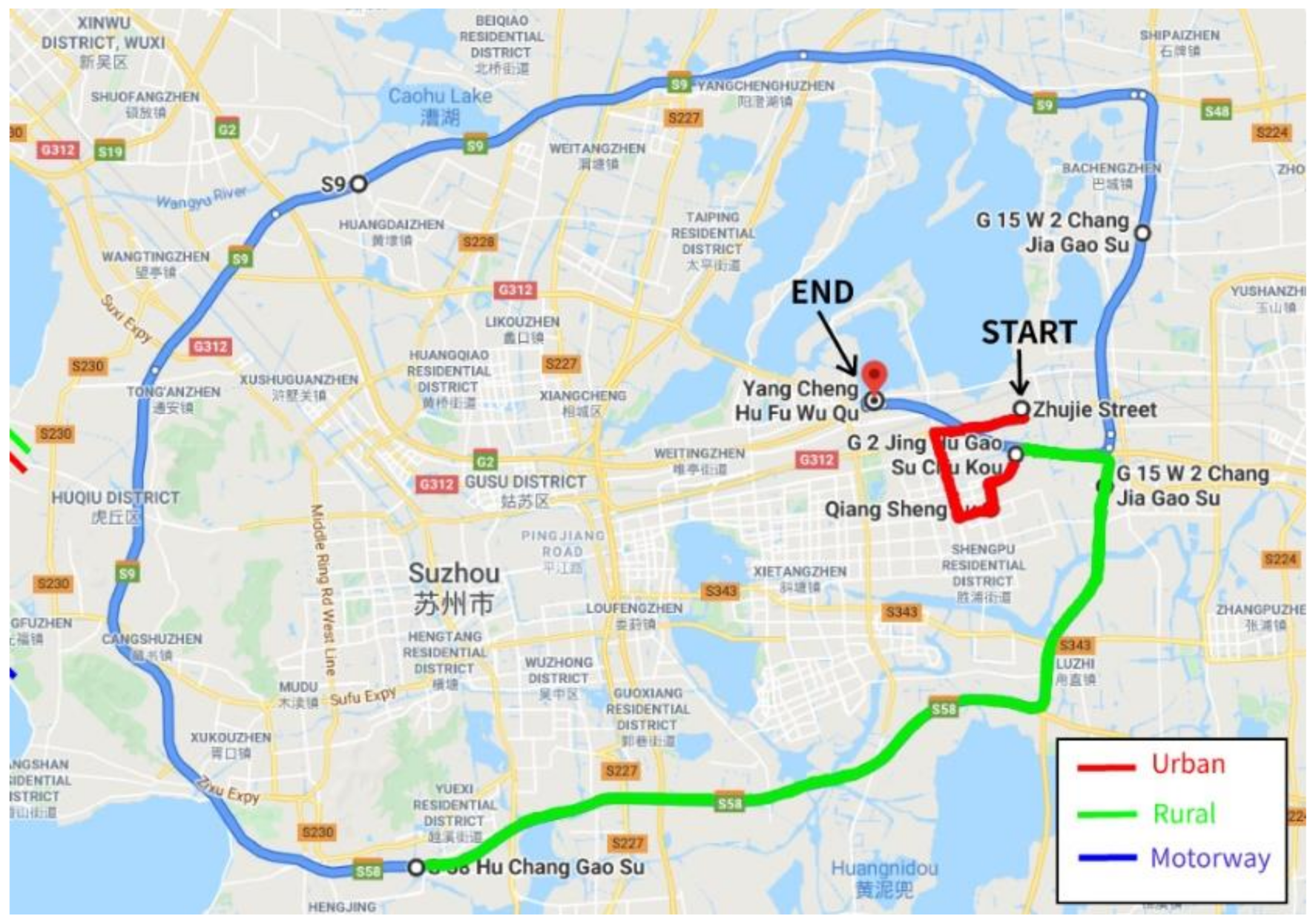
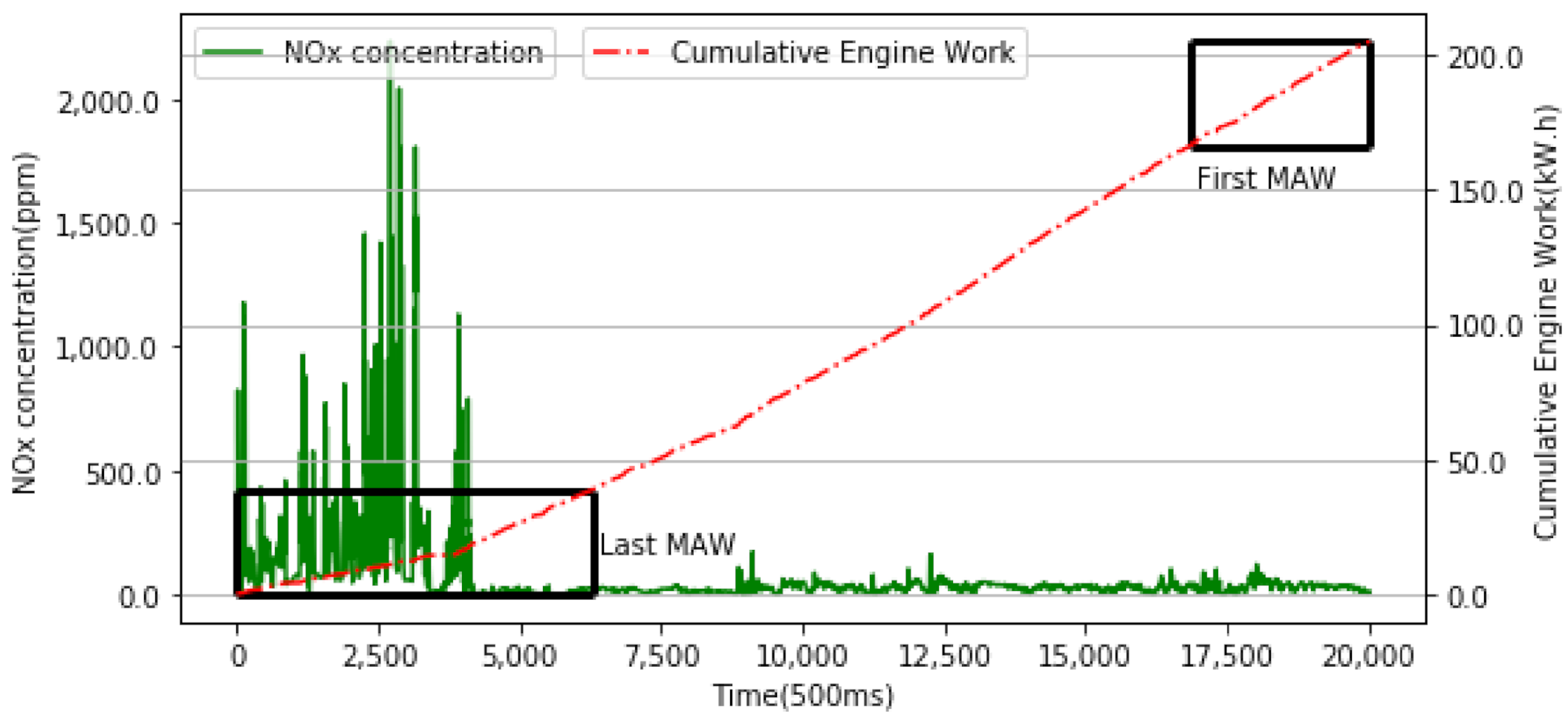
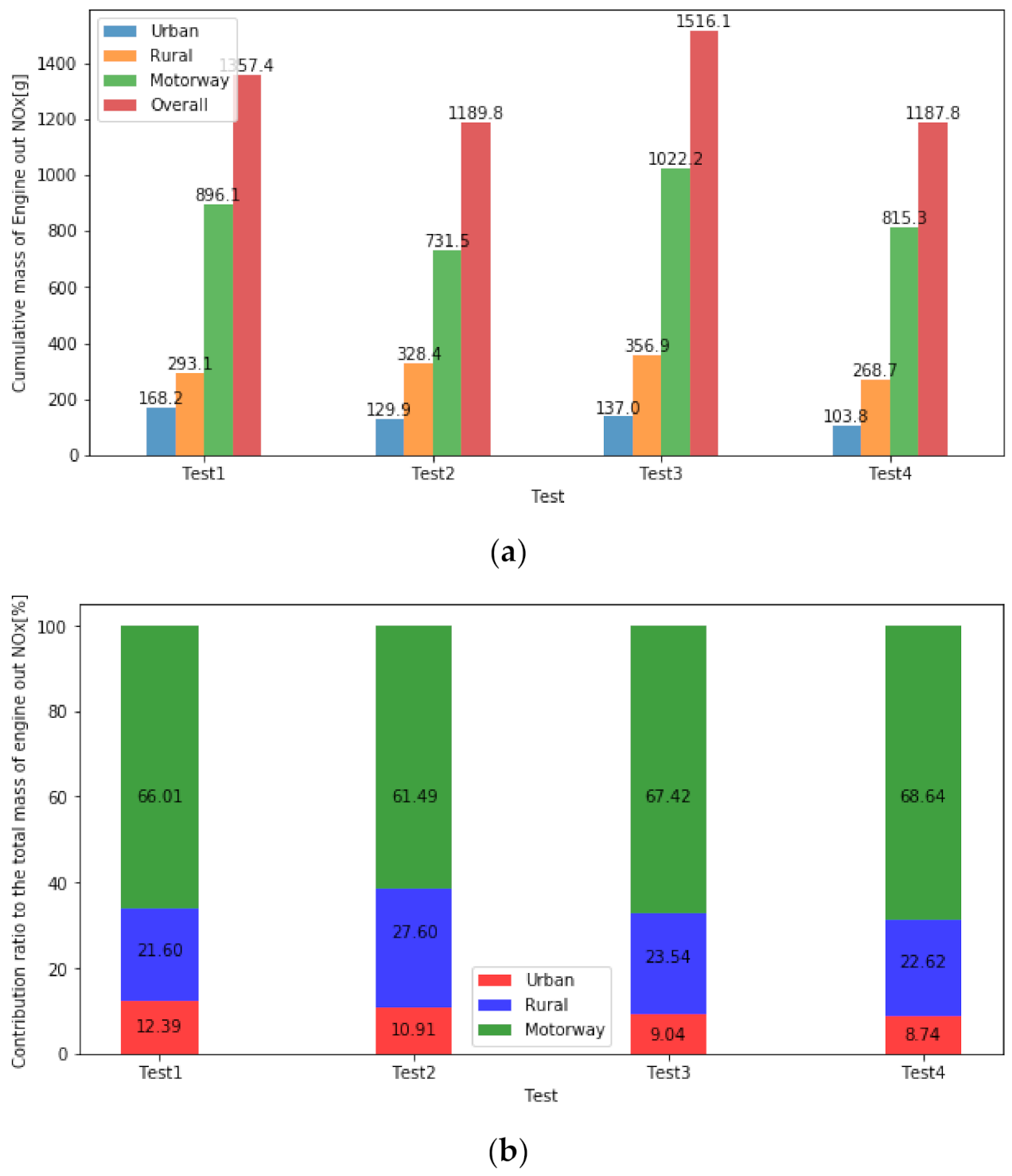

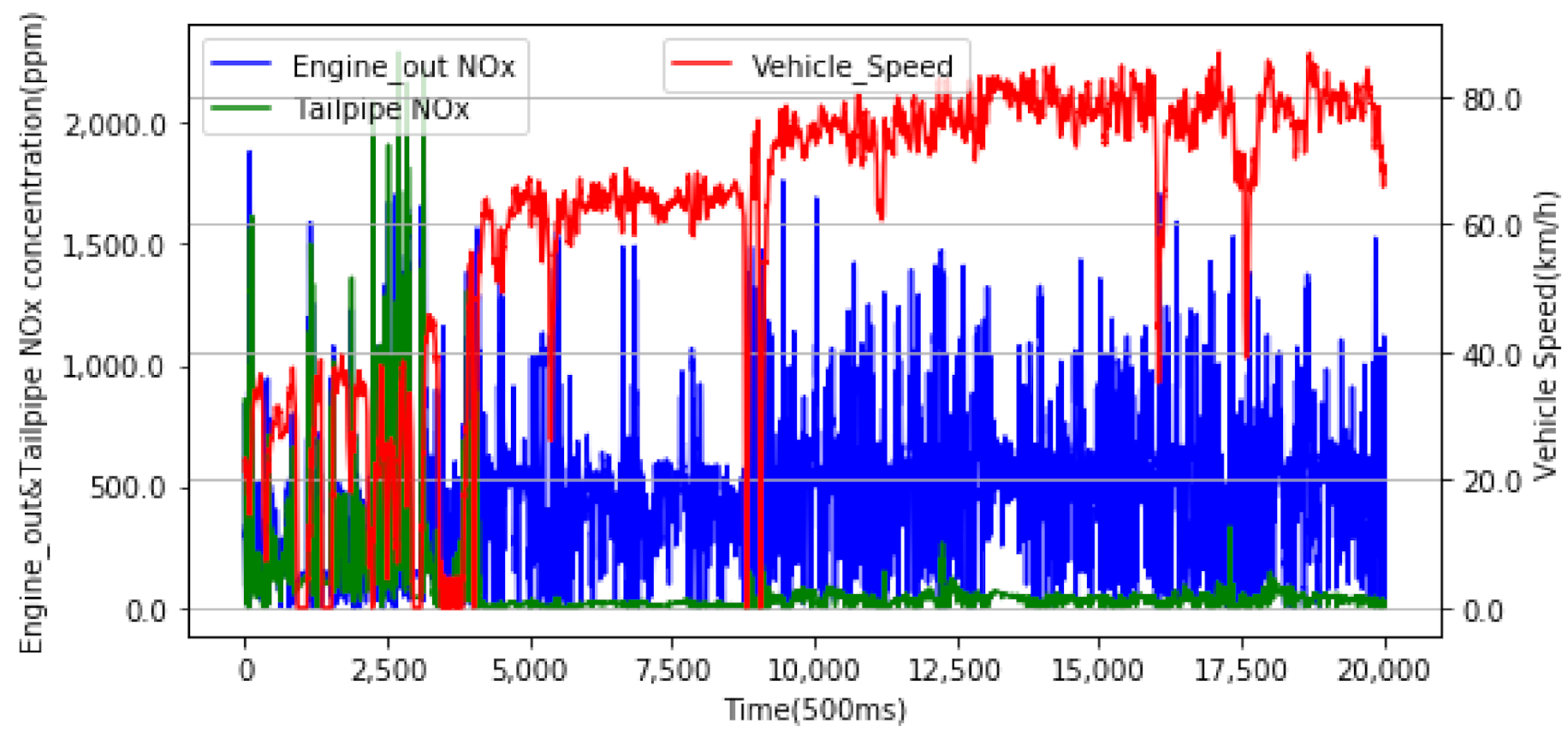
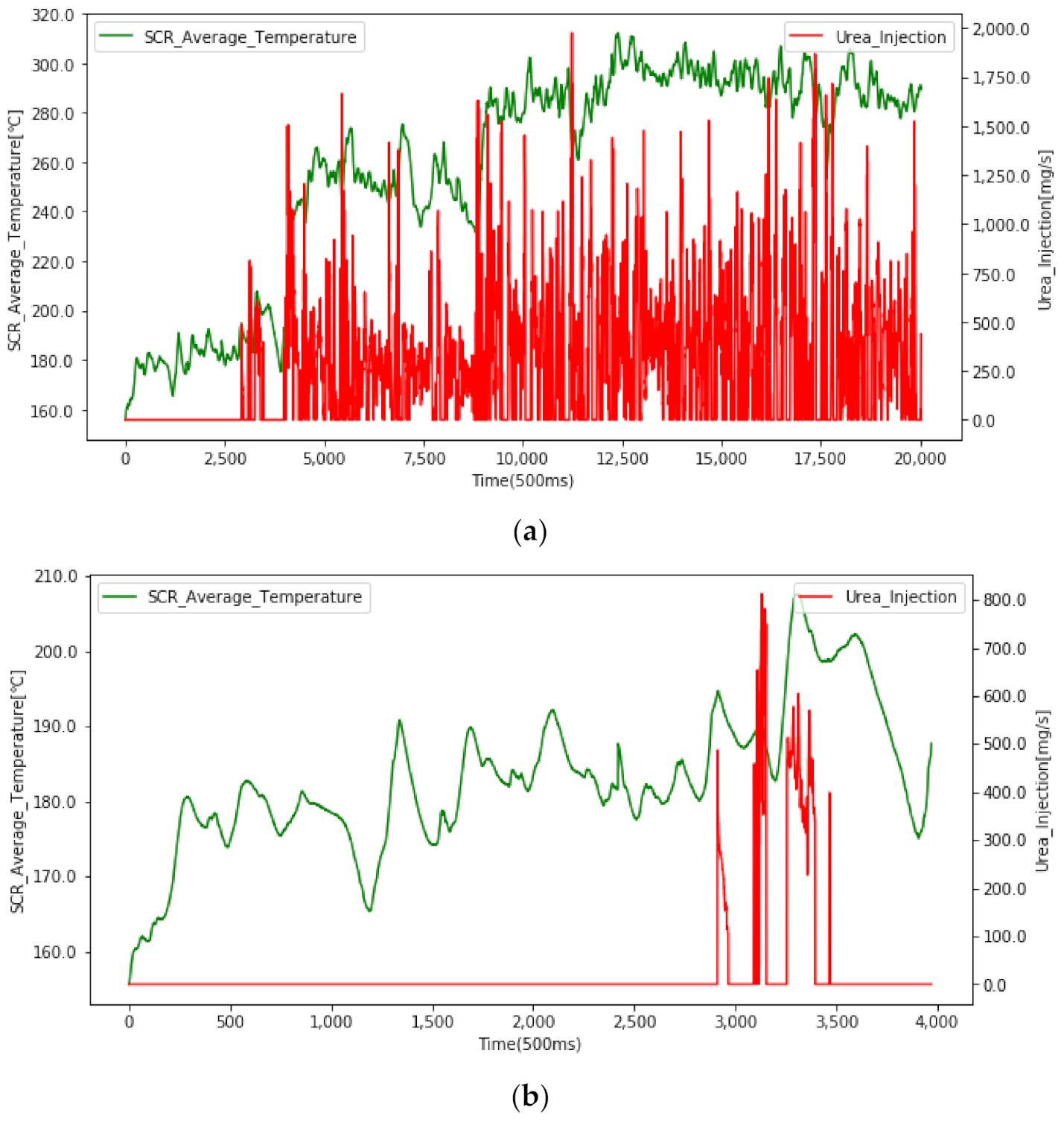
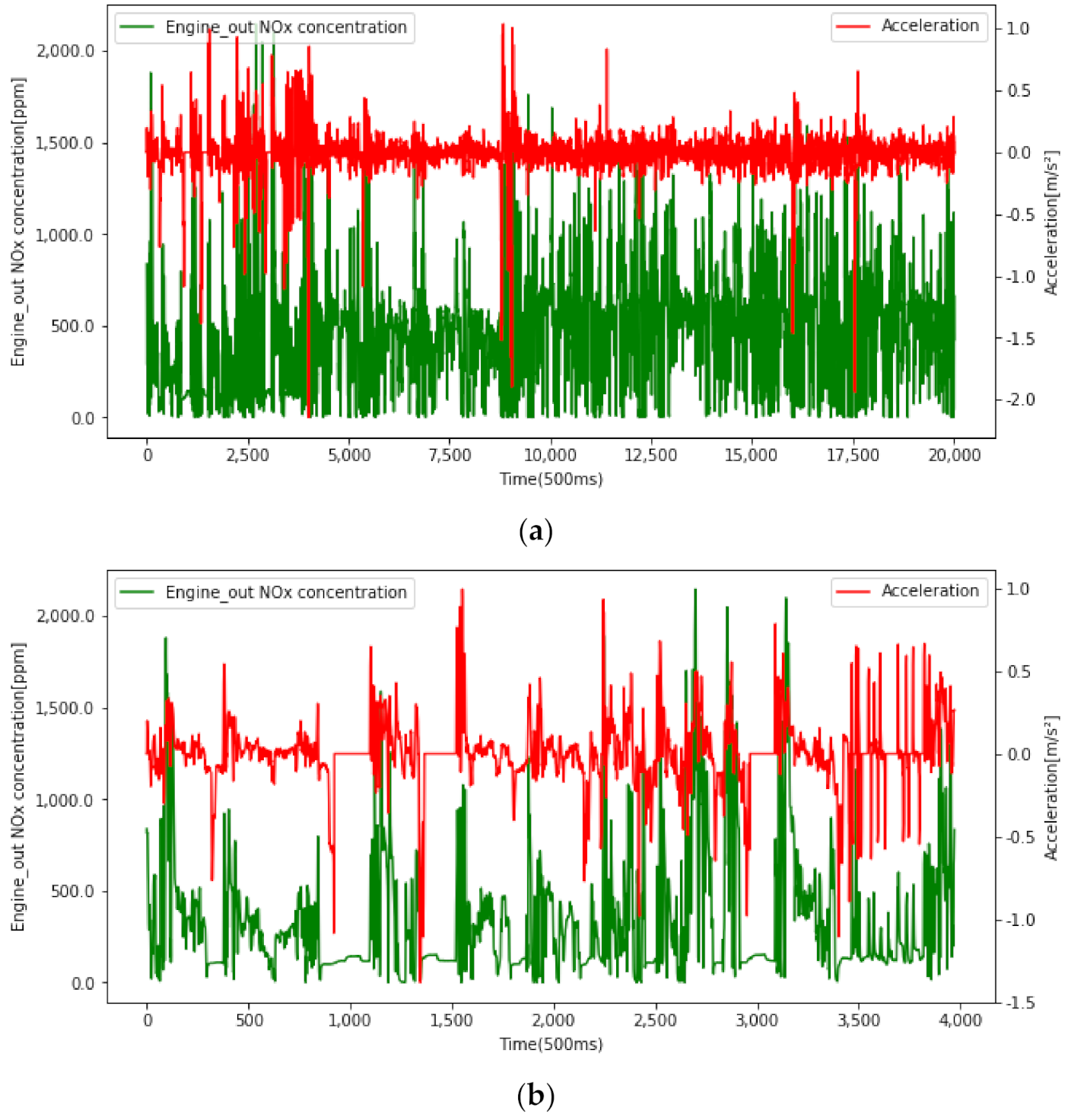
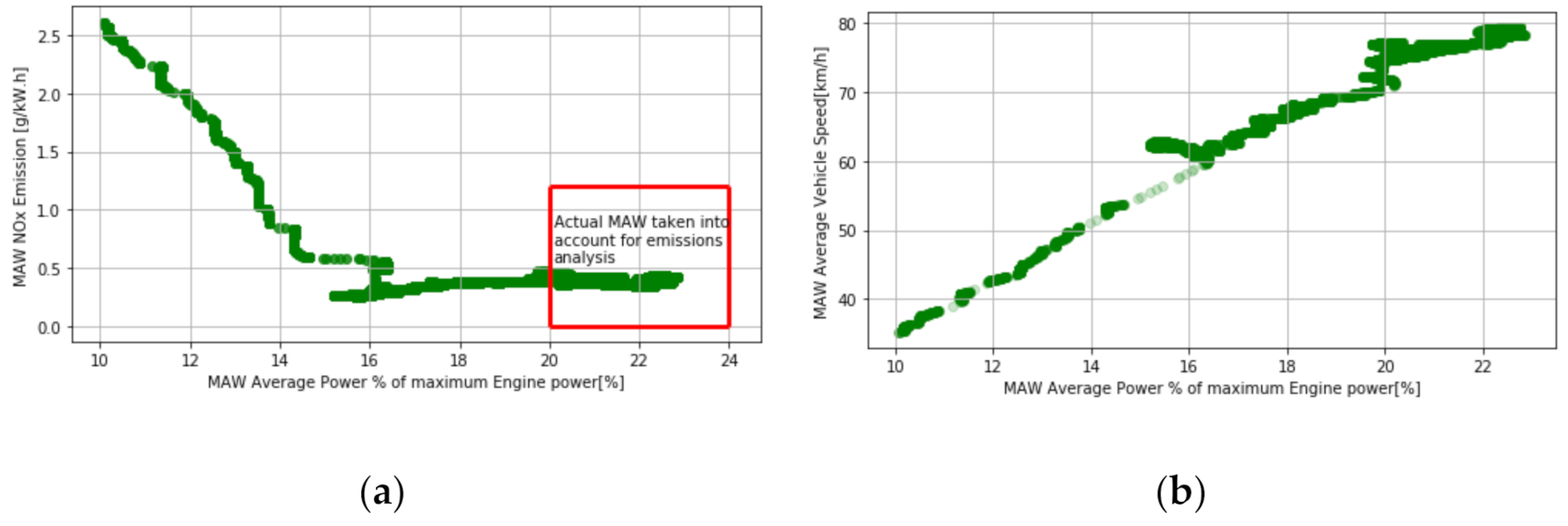
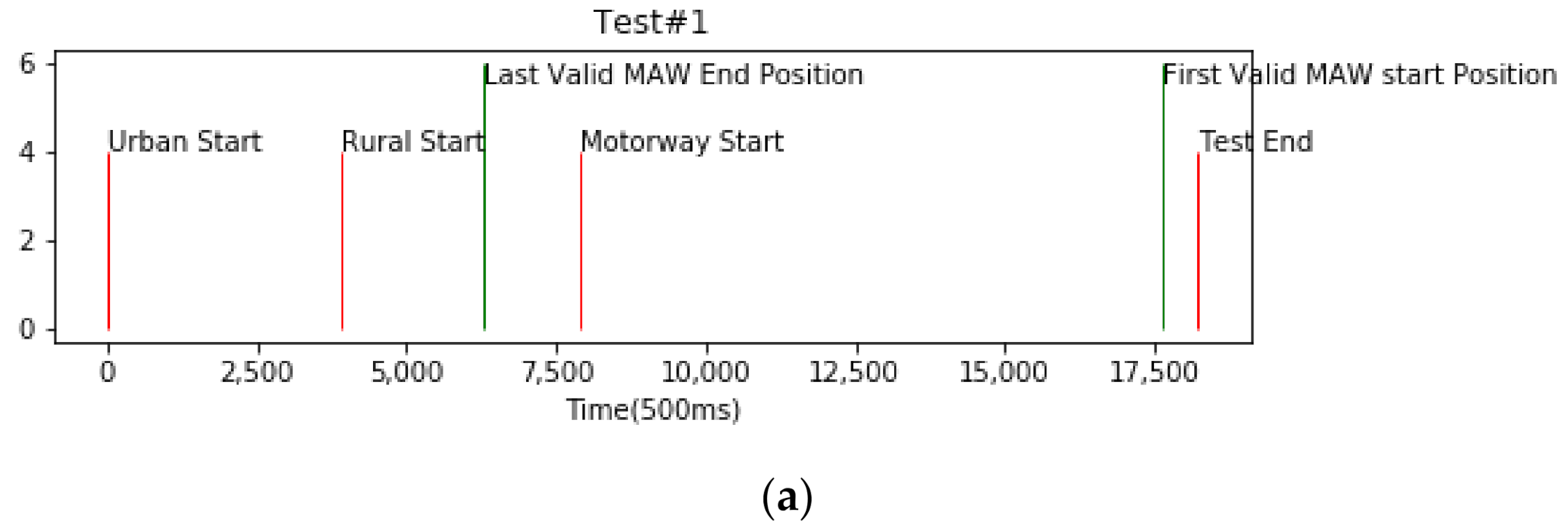

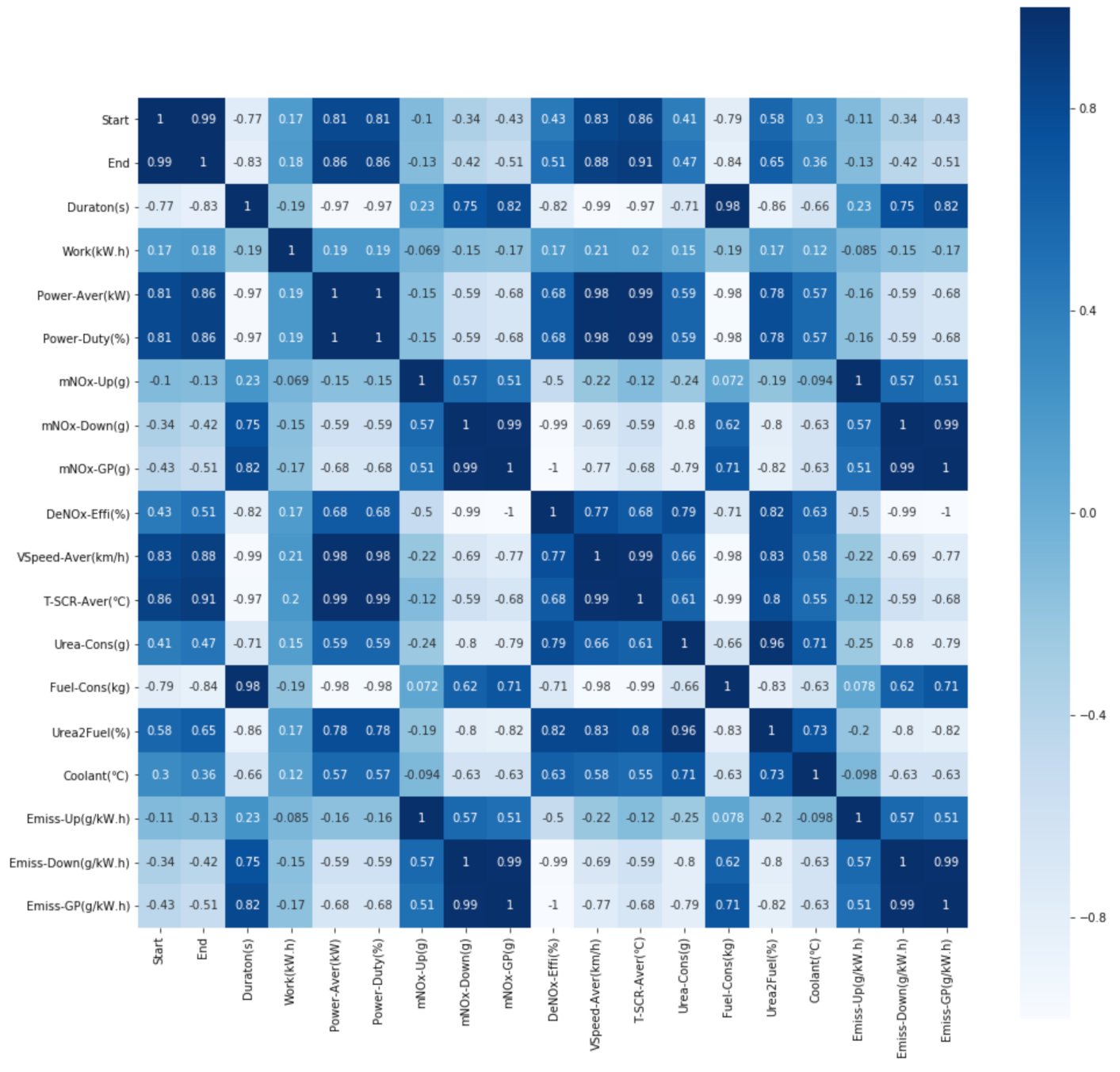


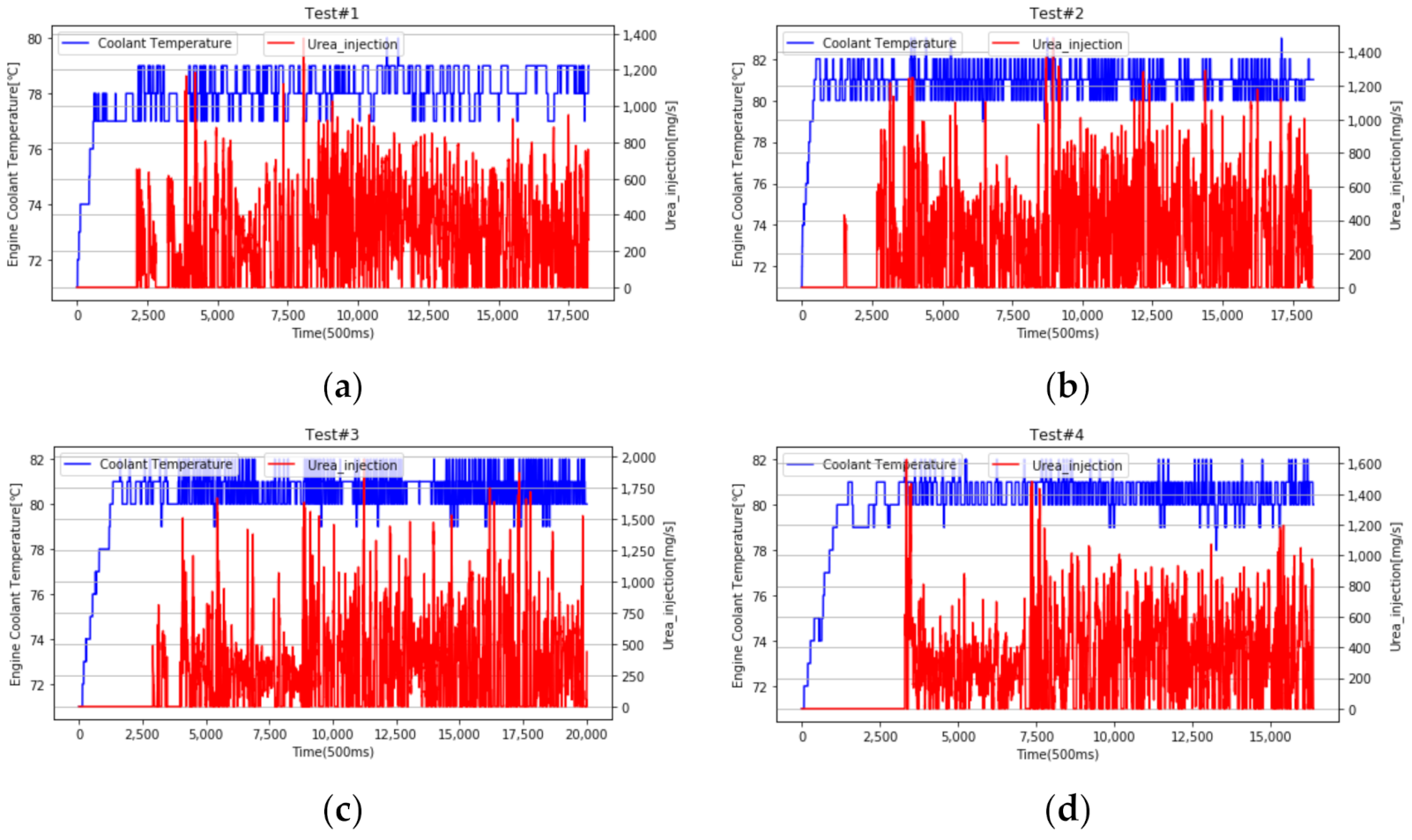
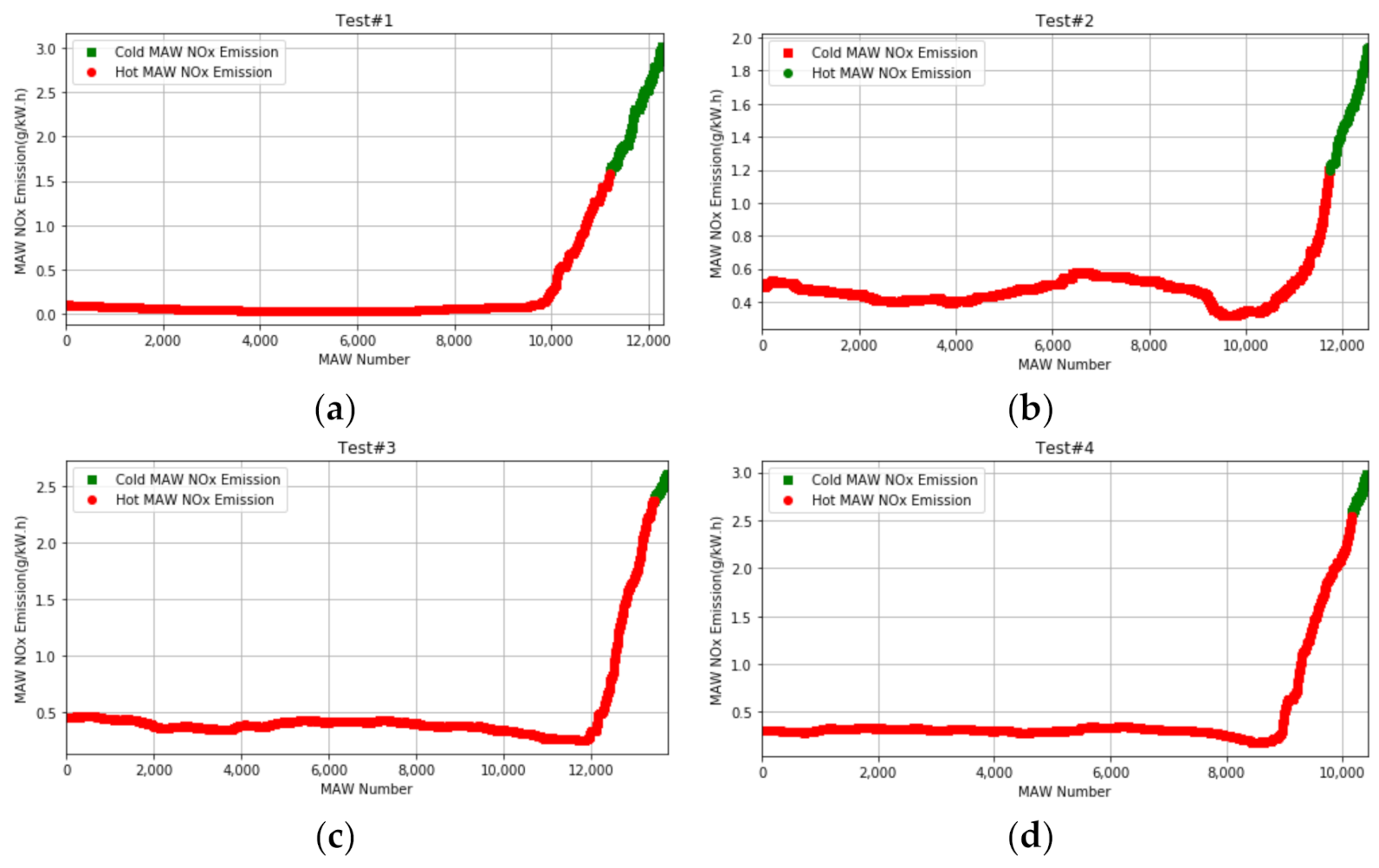
| Type of Engine | XX13600-60 |
|---|---|
| Type of Vehicle | Long–Haul |
| Year of production | 2019 |
| Engine rated power | 441 kW |
| Reference Torque | 3000 Nm |
| WHTC Cycle Work | 38.72 kWh |
| Emission standard | China VI (step B) |
| Aftertreatment System | DOC + DPF + SCR + ASC |
| Gross vehicle weight | kg |
| Payload | 50% |
| Category of vehicle | N3 |
| Fuel | China VI Standard |
| DEF | Adblue (32.5%) |
| Measured Variable | Measurement Principle | Measurement Range |
|---|---|---|
| CO | NDIR | 0~49,999 ppm |
| CO2 | NDIR | 0~20 vol% |
| NO | NDUV | 0~5000 ppm |
| NO2 | NDUV | 0~2500 ppm |
| THC | FID | 0~30,000 ppm |
| Test 1 | Test 2 | Test 3 | Test 4 | |
|---|---|---|---|---|
| Altitude not more than 2400 m | Yes | Yes | Yes | Yes |
| Cold start | Yes | Yes | Yes | Yes |
| Average Ambient temperature (°C) | 22.9 | 20.0 | 10.4 | 6.7 |
| Average relative humidity (%) | 96.3 | 69.6 | 66.2 | 65.9 |
| Payload (%) | 50 | 50 | 50 | 50 |
| Urban first (urban-rural-motorway) | Yes | Yes | Yes | Yes |
| Urban share driving (%) | 21.4 | 21.2 | 19.8 | 20.4 |
| Rural share (%) | 22.1 | 27.0 | 25.1 | 25.2 |
| Motorway share (%) | 56.5 | 51.7 | 55.0 | 54.4 |
| Urban driving average speed (km/h) | 25.3 | 24.4 | 21.6 | 23.5 |
| Rural driving average speed (km/h) | 55.4 | 60.9 | 60.9 | 57.7 |
| Motorway driving average speed (km/h) | 75.5 | 73.0 | 75.8 | 76.5 |
| Odometer (km) | 2135.3 | 10,557.4 | 47,443.5 | 82,258.3 |
| Trip distance (km) | 168.8 | 159.1 | 178.4 | 145.6 |
| Trip duration (s) | 9102 | 9117 | 10,009 | 8183 |
| Total Work (kWh) | 195.42 | 179.66 | 205.21 | 175.73 |
| Cumulative work (*WHTCWork) | 5.047 | 4.640 | 5.300 | 4.539 |
| Valid MAW Power Threshold (%) | 20 | 17 | 20 | 20 |
| Percentage of valid MAWs (%) | 61.5 | 72.3 | 50.2 | 64.3 |
| 95th NOx concentration (ppm) | 245.1 | 188.0 | 296.2 | 416.2 |
| 90th cumulative percentile of Valid MAWs NOx emission (g/kWh) | 0.068 | 0.551 | 0.438 | 0.337 |
| Test Valid or not | Valid | Valid | Valid | Valid |
| Section | Test 1 | Test 2 | Test 3 | Test 4 | |
|---|---|---|---|---|---|
| Engine out NOx emission [g/kWh] | Urban | 8.162 | 6.647 | 8.105 | 7.114 |
| Rural | 6.578 | 6.640 | 7.212 | 6.838 | |
| Motorway | 6.466 | 6.610 | 7.330 | 6.691 | |
| Overall | 6.665 | 6.622 | 7.363 | 6.759 | |
| Tailpipe NOx emission [g/kWh] | Urban | 5.054 | 3.519 | 5.637 | 7.388 |
| Rural | 0.395 | 0.370 | 0.344 | 0.271 | |
| Motorway | 0.059 | 0.502 | 0.413 | 0.317 | |
| Overall | 0.648 | 0.794 | 0.811 | 0.893 |
| Test 1 | Test 2 | Test 3 | Test 4 | |
|---|---|---|---|---|
| MAW Number | 12,291 | 12,513 | 13,742 | 10,432 |
| Valid MAW Number | 7562 | 9047 | 6895 | 6709 |
| Valid MAW Ratio (%) | 61.5 | 72.3 | 50.2 | 64.3 |
| Power Threshold (%) | 20 | 17 | 20 | 20 |
| 90th cumulative percentile of Valid MAWs NOx emission (g/kWh) | 0.068 | 0.551 | 0.438 | 0.337 |
| Real NOx emission of the entire trip (g/kWh) | 0.648 | 0.794 | 0.811 | 0.893 |
| Error 90th Valid MAW to Overall (%) | −89.48 | −30.59 | −45.91 | −62.29 |
| Test 1 | Test 2 | Test 3 | Test 4 | |
|---|---|---|---|---|
| MAW NOx emission [g/kWh] | ||||
| MAW Duration (s) | 0.910 | 0.739 | 0.817 | 0.842 |
| MAW Average Power (kW) | −0.800 | −0.590 | −0.678 | −0.730 |
| MAW Cumulative NOx Mass (g) | 1.000 | 1.000 | 1.000 | 1.000 |
| MAW DeNOx Efficiency (%) | −0.999 | −0.998 | −1.000 | −1.000 |
| MAW Average Vehicle Speed (km/h) | −0.876 | −0.744 | −0.772 | −0.775 |
| MAW Average SCR Temperature (°C) | −0.885 | −0.641 | −0.677 | −0.751 |
| MAW Fuel Consumption (kg) | 0.995 | 0.623 | 0.709 | 0.807 |
| MAW engine coolant(°C) | -0.871 | -0.620 | -0.632 | -0.672 |
| MAW NOx Emission (g/kWh) | 1.000 | 1.000 | 1.000 | 1.000 |
| Method | Parameters | Test 1 | Test 2 | Test 3 | Test 4 |
|---|---|---|---|---|---|
| —— | Real NOx emission of the entire trip (g/kWh) | 0.648 | 0.794 | 0.811 | 0.893 |
| Method 1 | Power Threshold (%) | 10 | 10 | 10 | 10 |
| NOx emission by Method 1 (g/kWh) | 1.43 | 0.611 | 0.645 | 1.203 | |
| Error1 (Method 1 to Real NOx emission) | 120.7% | −23.1% | −20.4% | 34.6% | |
| MAW Number | 12,291 | 12,513 | 13,742 | 10,432 | |
| Valid MAW Number | 12,291 | 12,513 | 13,742 | 10,432 | |
| Valid MAW Ratio | 100% | 100% | 100% | 100% | |
| Method 2 | Power Threshold (%) | 10 | 10 | 10 | 10 |
| NOx emission by Method 2 (g/kWh) | 0.619 | 0.773 | 0.833 | 0.812 | |
| Error2 (Method 2 to Real NOx emission) | −4.5% | −2.7% | 2.8% | −9.1% | |
| Reference Vehicle Speed (km/h) | 55.4 | 60.9 | 60.9 | 57.7 | |
| Method 3 | Power Threshold (%) | 10 | 10 | 10 | 10 |
| NOx emission by Method 3 (g/kWh) | 0.661 | 0.784 | 0.763 | 0.955 | |
| Error3 (Method 3 to Real NOx emission) | 2.0% | −1.2% | −5.9% | 6.9% | |
| Reference Engine Coolant Temperature (°C) | 78.0 | 80.8 | 80.4 | 80.1 |
Publisher’s Note: MDPI stays neutral with regard to jurisdictional claims in published maps and institutional affiliations. |
© 2021 by the authors. Licensee MDPI, Basel, Switzerland. This article is an open access article distributed under the terms and conditions of the Creative Commons Attribution (CC BY) license (http://creativecommons.org/licenses/by/4.0/).
Share and Cite
Li, P.; Lü, L. Evaluating the Real-World NOx Emission from a China VI Heavy-Duty Diesel Vehicle. Appl. Sci. 2021, 11, 1335. https://doi.org/10.3390/app11031335
Li P, Lü L. Evaluating the Real-World NOx Emission from a China VI Heavy-Duty Diesel Vehicle. Applied Sciences. 2021; 11(3):1335. https://doi.org/10.3390/app11031335
Chicago/Turabian StyleLi, Peng, and Lin Lü. 2021. "Evaluating the Real-World NOx Emission from a China VI Heavy-Duty Diesel Vehicle" Applied Sciences 11, no. 3: 1335. https://doi.org/10.3390/app11031335
APA StyleLi, P., & Lü, L. (2021). Evaluating the Real-World NOx Emission from a China VI Heavy-Duty Diesel Vehicle. Applied Sciences, 11(3), 1335. https://doi.org/10.3390/app11031335





